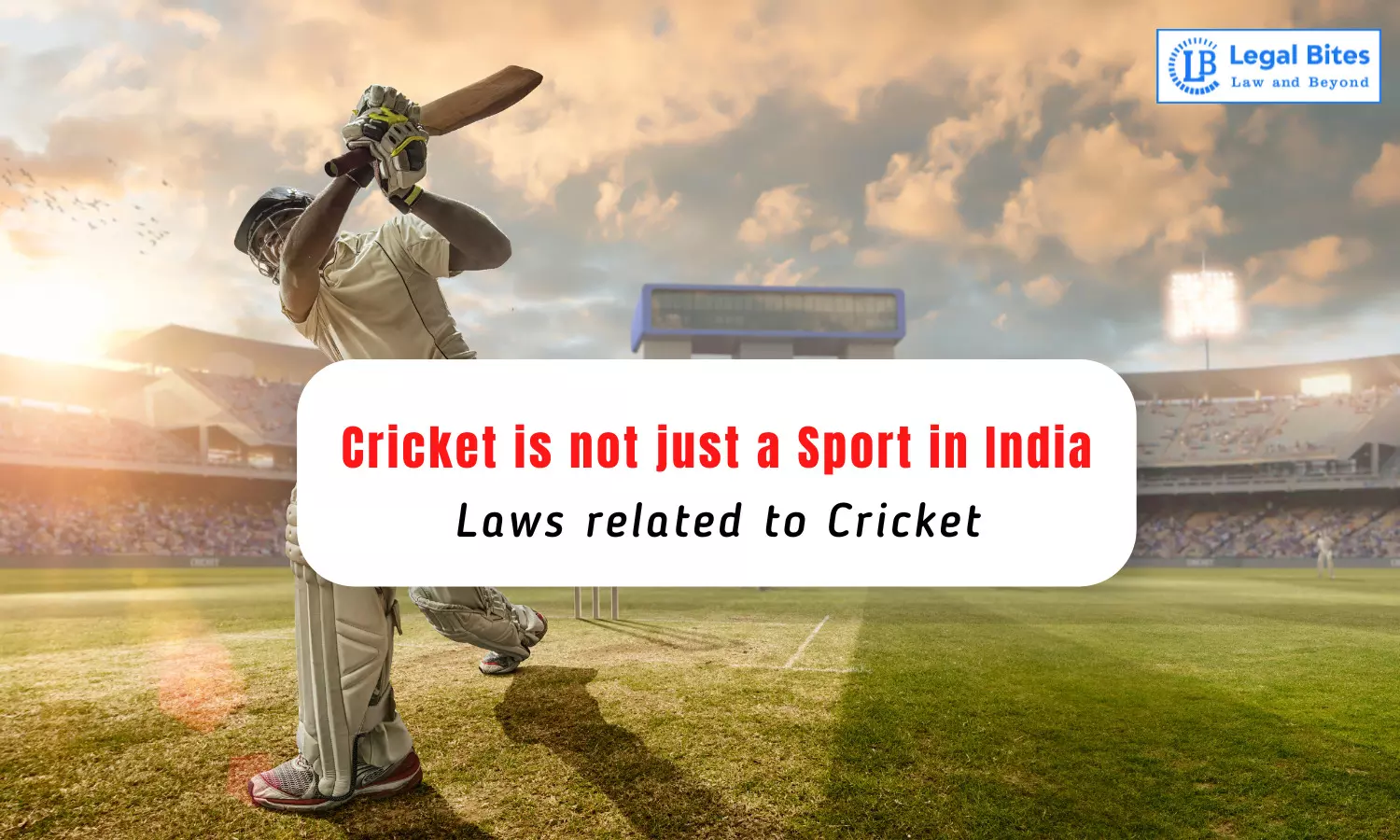Cricket is not just a Sport in India | Laws related to Cricket
The article 'Cricket is more than a Sport in India' will discuss the evolution of cricket from the 1600s till date, its technological developments, and will highlight the greatest of the matches in the history of cricket.

The article 'Cricket is not just a Sport in India (Laws related to Cricket) will discuss the evolution of cricket from the 1600s till date, its technological developments, and will highlight the greatest of the matches in the history of cricket.
Introduction
In Cricket, a match is played between two teams of 11 players each on a circular/ oval field. There are three formats of cricket, i.e., one-day innings (ODI), each team gets 50 overs each per innings, twenty20 (T20), each team gets 20 overs each per innings, and test format. Most tournaments are played between international teams. For example, the world cup of both ODI and T20 formats, the Asia Cup, and series and tours of various countries.
Evolution of Cricket
Early Cricket:
Cricket was first played by children during the Saxon and Norman times in the Weald, southeast England. But by the adults, it was first played in the year 1611 as a boy's sport. It is believed that cricket was derived from the bowls, where a batsman used to intervene and tried the ball from reaching its target by hitting it away.
In the mid-17th Century, village cricket developed, and there was the formation of county teams, the first known game in which teams use county names were in 1709, and local experts were hired as the earliest professionals.
It was not until the 18th century; cricket was established as a leading sport in London and the south-eastern countries of England. Further, women's cricket was developed in the year 1745. In 1744 the laws of cricket were written and later amended in 1774, the amendment included innovations such as a 3rd stump (middle stump), lbw (Leg Before Wicket), and a maximum bat width. The Star and Garter Club wrote the code of laws and later founded the Marylebone Cricket Club (MCC) at Lord's in 1787. Prior to the MCC, the Hambledon Club in Hampshire was in charge for 30 years. After that, MCC was and is currently the custodian of the laws of cricket.
Earlier, a hockey stick style of bat was used, which was replaced by the straight bat. Rolling the ball on the ground by the bowlers was also banned. The spread of cricket in North America was due to the English Colonies in the 17th Century. Similarly, it was introduced to the West Indies and by the British East India Company in India in the 18th Century, similarly, it reached other commonwealth countries that were captured by the British. Like it arrived in Australia in 1788, and in New Zealand and South Africa in the 19th Century.
19th Century:
In the 19th century, during the Napoleonic wars, the game survived a lack of investment. In 1839 Sussex formed the first English county clubs. In 1846 "All England Eleven" was formed as a commercial venture, which spread the game to areas that never saw top-class cricket beforehand. The development of the railways was another factor that led to the spread of railways. Also, the British Army Units around the world encouraged the locals to play the sport, which also led to its spread.
The first woman's county match was played in 1811. Women's matches back then were played in front of huge crowds, unlike nowadays, where we see fewer crowds for a woman's matches. In 1864, overarm bowling was legalized. In the same year first Wisden Cricketers' Almanack. Also, that year marked the beginning of the influential career of W. G. Grace, which increased the popularity of Cricket.
In 1844 the first international cricket match was played between USA and Canada at St George's Cricket Club in New York, followed by an overseas tour in the year 1859 between North America and England. In 1865 the Australian Aborigines became the first Australian Cricket team to travel overseas to England.
1n 1890 the first official County Championship was organized in England. In 93' the Currie Cup was played in South Africa and Sheffield Shield in Australia. The first world war became the Golden Age of Cricket, it featured great cricketers such as Grace, Wilfred Rhodes, C. B. Fry, Ranjitsinhji, and Victor Trumper.
20th Century:
In the 20th century, specifically in 1909, the Imperial Cricket Conference (ICC) was formed in England, back then, only England, Australia, and South Africa were members. Followed by West Indies (1928), New Zealand (1930), and India (1932) became Test nations before the Second World War.
India introduced the Ranji trophy in 1934, and Pakistan founded the Quaid-e-Azam trophy in 1953. In 1958 the International Women's Cricket Council was founded, which in 2005 merged with the ICC. The first women's world cup was hosted by England, which eventually they won and Rachel Heyhoe-Flint was the player of the match. With the birth of the national league, the popularity and no. of county championships' matches died.
The first men's world cup was played in 1975 in England, wherein the West Indies won.
In 1970, apartheid led to the suspension of South Africa from the International Cricket Competition. During this period, "rebel tours" was taken up by the South African Cricket Board for international players to form teams and tour South Africa. In 1991 South Africa Joined International Cricket due to the end of Apartheid. They played the world cup in 1992 and later on went to play the 'return' Test Match against the West Indies in Barbados.
The world cup of 1987 (India won) was the last event to be played with a red ball with white clothing, after that, all the events were played with a white ball. Sri Lanka became part of the Test Nation in 1982, Zimbabwe in 1992, and Bangladesh in 2000.
21st Century:
It is a century of technological developments, and many innovations were introduced in the sport. In 2003 the first t20 match was played in England. Later on, in 2005 that became an international cricket format in men's T20 international cricket. In 2007 India won the final of the first T20 World Cup against Pakistan in Johannesburg, which had an audience of over 400 million. This led to the founding of the Indian Premier League. From then the innovations continued to rise, such as ball tracking, flashing stumps and bails for ensuring accurate run-out decisions, infra-red cameras, edge detection technology, and Duckworth-Lewis-Stern (a method used to calculate targets and results when unfavorable weather strikes in limited-overs matches.)
Laws of Cricket
There are a total of 42 laws of cricket, which are as follows:
Law one talks about the number of players which is 11 in each team, nomination, and replacement of players, that the deputy captain shall take over the post of the captain, in his absence, and the responsibility of captains that ensures that the game is played with the Spirit of cricket.
Law two talks about the umpires with respect to their appointment and attendance, change of umpire, their duties with respect to wickets, creases, and boundaries, and ensure that the conduct of the match is in accordance with the laws, and judging a game as to unfair and fair, also whether the conditions of ground are suitable to play, and that the umpires shall change ends after one complete inning, and shall give their judgment by the way of the symbol.
Law three talks about the scores, that is appointment of scores, the correctness of scores, and acknowledgment of signals.
Law four talks about the ball that is its size, approval & control of balls, a new ball should be used each day if a match is of more than one day's duration, and a new ball should be used if the last ball cannot be found, or becomes unfit for use, the weight of the ball should be as specified 140-151g for women, 155-163g for men.
Law five states that that bat should have a blade and one handle, its size limit, weight, etc. Law six talks about pitch, its area, fitness, non-turf pitches, etc. Law seven talks about the creases which are the bowling crease, popping crease, and return creases.
Law eight talks about wickets, their description, width, pitching, the size of stumps, and the bails. Law nine talks about the preparation and maintenance of the playing area. Law ten talks about covering the pitch after the match and uncovering it before the match. Law eleven talks about an interval (between innings, meals, drinks, and any other interval as discussed).
Law thirteen talks about the innings that there may be one or two innings or, as may be discussed, alternate innings completed innings, and the toss winner captain shall decide the innings. Law fifteen talks about declaration and forfeiture of innings. Law sixteen talks about the result that the result cannot be changed once decided by the umpires. Law seventeen talks about the over that are the number of balls per over, the start of an over, and the validity of balls. Law nineteen talks about boundaries that identify, mark, and restore them. Law twenty is about dead balls. etc.
Remarkable Cricket Match (brief descriptions)
World Cup Final of 1983- wherein India won the world cup for the first time in the History of Cricket. This match was held Lord's against West Indies on 25th June 1983.
2011 World Cup Final of 2011- India v. Sri Lanka, where India lifted the ODI World Cup Trophy for the second time.
T20 World Cup Final 2007- India v. Pakistan, the T20 world cup was being played for the first time and Inda secured it with winning the Final against Pakistan on
Group Match of 2007 T20 World Cup- when Yuvraj Singh hit 6 sixes after that Harshal Gibs hit 6 sixes in an over in the Netherlands in 2007 in an ODI.
India v. Australia Perth Test Match in 2012, Perth is a very fast pitch, and it is very difficult to beat Australia on that ground, India after losing quite many times, won in that match.
Australia v. South Africa, 2006 series Match, Australia gave an unbeatable target of 434 runs in 50 overs on 12th March 2006, still South Beat them in Johannesburg.
England v. Netherlands Match was the highest-scoring ODI match, wherein England scored a high of 498 runs in Amstelveen on17 Jun 2022.
Afghanistan v. Ireland Match was the highest-scoring T20 match, wherein Afghanistan scored a high 278 runs in Dehradun on 23rd February 2019.
India v. Sri Lanka Match of 1997, wherein Sri Lanka scored a high of 952 runs in 271 overs in Colombo, on 2nd August 1997.
Conclusion
The sport has seen massive development since the day it was invented, it is now the most followed sport in India, and people treat cricket players as stars. Virat Kohli is the current centre of attraction, after the former
captain MS Dhoni, who is the only captain in the history of Cricket who won 3 ICC trophies. There is no other game in India that has so much support from the Indians. Whenever there is a match between India v. Pakistan, the audience's excitement is to its maximum, which has its own reasons whatsoever.
References
1. 19th Century Cricket, Available Here
2. 20th Century Cricket, Available Here
Important Links
Law Library: Notes and Study Material for LLB, LLM, Judiciary, and Entrance Exams

